
Echinacea angustifolia, the narrow-leaved purple coneflower or blacksamson echinacea, is a species of flowering plant in the family Asteraceae. It is native to North America, where it is widespread across much of the Great Plains of central Canada and the central United States, with additional populations in surrounding regions.

Monarda citriodora is a species of flowering plant in the mint family, Lamiaceae, that is native to the southern United States and northern Mexico. Common names include lemon beebalm, lemon mint and purple horsemint. When crushed, the leaves emit an odor reminiscent of lemons. This odor is sometimes described as more resembling oregano, especially late in the season. Its purple flowers are highly attractive to butterflies, bees and hummingbirds.

Grindelia squarrosa, also known as a curly-top gumweed or curlycup gumweed, is a small North American biennial or short-lived perennial plant.
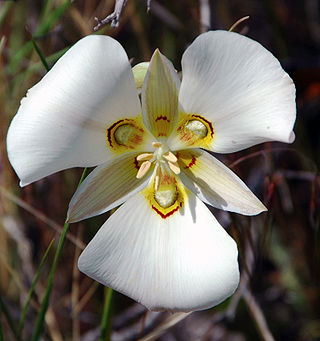
Calochortus nuttallii, also known as the sego lily, is a bulbous perennial plant that is endemic to the Western United States. The common name of sego comes from a similar Shoshone word. It is the state flower of Utah.

Ericameria nauseosa, commonly known as chamisa, rubber rabbitbrush, and gray rabbitbrush, is a shrub in the sunflower family (Aster) found in the arid regions of western North America.

Ratibida columnifera, commonly known as upright prairie coneflower, Mexican hat, and longhead prairie coneflower, is a perennial species of flowering plant in the genus Ratibida in the family Asteraceae. It is native to much of North America and inhabits prairies, plains, roadsides, and disturbed areas from southern Canada through most of the United States to northern Mexico.

Brickellia grandiflora, known by the common name tasselflower brickellbush, is a species of flowering plant in the family Asteraceae.

Chaenactis douglasii is a North American species of flowering plant in the daisy family known by the common name Douglas' dustymaiden.

Crepis occidentalis is a North American species of flowering plant in the family Asteraceae known by the common names western hawksbeard, or largeflower hawksbeard. It is native to western Canada and the western United States.

Thelesperma is a genus of North American and South American plants in the cosmos tribe within the sunflower family. Greenthread is a common name for plants in this genus.

Mentzelia multiflora, commonly known as Adonis blazingstar, Adonis stickleaf, desert blazingstar, prairie stickleaf and manyflowered mentzelia is a herbaceous perennial wildflower of the family Loasaceae.
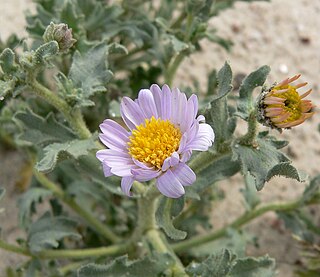
Leucosyris arida is an annual plant in the family Asteraceae, known by the common names arid tansyaster, desert tansyaster, and Silver Lake daisy. It is native to the very arid deserts of northern Mexico and the southwestern United States, and usually looks straggly and not very attractive. But in years with very heavy rainfall, it fills out and becomes rounded and bush like.

Dieteria canescens is an annual plant or short lived perennial plant in the family Asteraceae, known by the common names hoary tansyaster and hoary-aster.

Grindelia ciliata is a species of flowering plant in the family Asteraceae known by the common names Spanish gold, goldenweed, and waxed goldenweed.
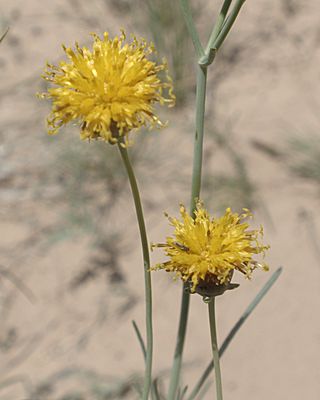
Thelesperma megapotamicum is a perennial species of flowering plant in the aster family known by the common name wild tea and rayless greenthread. It is native to sections of the Americas, including the central United States, where it grows in many types of habitat.

Antennaria parvifolia is a species of flowering plant in the family Asteraceae, known by the common names small-leaf pussytoes and Nuttall's pussytoes. It is native to western and central North America.

Verbena stricta, also known as hoary verbena or hoary vervain, is a small purple wildflower native to a large region of the central United States.
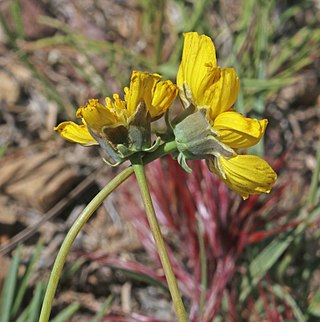
Thelesperma subnudum, commonly known as Navajo tea, is a perennial species of flowering plant in the family Asteraceae. It is found from west central Canada to central United States. It grows in openings in pinyon/juniper or yellow pine forests.
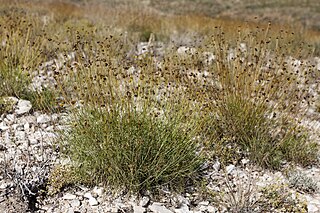
Thelesperma longipes, the longstalk greenthread, is a perennial species of flowering plant in the aster family. It is found from Arizona to northeast Mexico.

Oxytropis splendens, commonly known as showy locoweed, is a flowering perennial in the legume family endemic to the east slope of the Rocky Mountains. Growing in Canada, Alaska, several Great Plains states, and parts of the Mountain West, O. splendens grows well in harsh alpine ecosystems, allowing it to quickly colonize gravel and coal spoils.





















